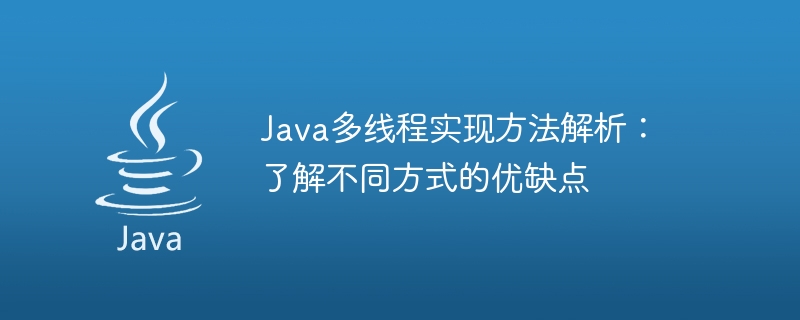

Java multi-threading is an important way to implement concurrent programming, which can better utilize the performance of multi-core processors and improve the running efficiency of the program. In Java, there are many ways to implement multi-threading. This article will introduce several common ways, analyze their advantages and disadvantages, and provide specific code examples.
This is the most basic multi-threading implementation. You only need to inherit the Thread class and override the run method. The specific implementation code is as follows:
public class MyThread extends Thread {
@Override
public void run() {
// 线程的逻辑代码
}
public static void main(String[] args) {
MyThread thread = new MyThread();
thread.start();
}
}Advantages: Simple and easy to use, suitable for simple concurrent tasks.
Disadvantages: Since Java only supports single inheritance, it is inconvenient to use this method to create multiple concurrent tasks.
By implementing the Runnable interface, tasks can be separated from threads, and the concurrency of multiple tasks can be achieved. The specific implementation code is as follows:
public class MyRunnable implements Runnable {
@Override
public void run() {
// 线程的逻辑代码
}
public static void main(String[] args) {
Thread thread = new Thread(new MyRunnable());
thread.start();
}
}Advantages: High flexibility, can easily achieve the concurrency of multiple tasks.
Disadvantages: You need to create a Thread object and pass the Runnable object as a parameter, which is a bit cumbersome.
The Executor framework in Java provides a more advanced thread control method that can easily manage the execution of concurrent tasks. The specific implementation code is as follows:
public class MyTask implements Runnable {
@Override
public void run() {
// 线程的逻辑代码
}
public static void main(String[] args) {
Executor executor = Executors.newFixedThreadPool(10);
for (int i = 0; i < 10; i++) {
executor.execute(new MyTask());
}
}
}Advantages: Using the Executor framework can easily manage the thread pool, control the number of concurrent tasks, and avoid the overhead of thread creation and destruction.
Disadvantages: Compared with the first two methods, the code using the Executor framework is slightly more complicated.
Summary:
Different multi-threading implementation methods are suitable for different situations. Here are some guidelines for reference:
In actual development, choosing a suitable multi-thread implementation method according to actual needs can better improve the concurrency and performance of the program. The above is just a brief introduction to some common implementation methods. More knowledge and skills about Java multi-threading require further study and practice.
The above is the detailed content of Understand the advantages, disadvantages and analysis of Java multi-threading implementation methods. For more information, please follow other related articles on the PHP Chinese website!




